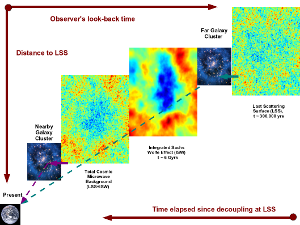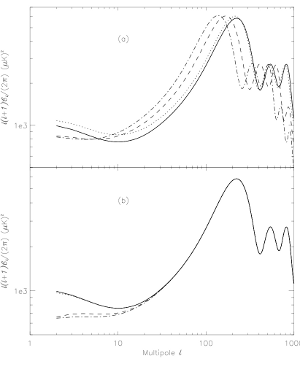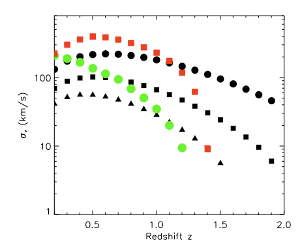|
|  |
The Cosmic Microwave Background radiation (CMB) was released 370,000 years
after the Big Bang, at the so-called Last Scattering Surface (LSS). Since
then, the CMB has crossed the whole visible Universe before reaching the
observer. It is a very isotropic radiation field, showing tiny angular
deviations in intensity and polarization (one part in ~100,000), most of which
were generated at the LSS.
At the same time, there is observational evidence that the Universe is
currently undergoing a phase of accelerated expansion. If true, this would
have a direct impact on the gravitational potential wells: an accelerated
growth of the scale of the Universe makes potential wells shallower on the
very large scales. The CMB photons crossing those regions leave a potential
well that was deeper than when they entered it, i.e., the CMB photons gain some
gravitational energy. The amount of energy earned will depend upon the
particular potential well, and will not be the same for all CMB
photons. Therefore this process introduces secondary anisotropies on the CMB,
and it is known as the Integrated Sachs-Wolfe effect (ISW). This process
should start occurring when the Universe is around 6-8 Gyrs old (or,
equivalently, for redshifts in the range z ~ 0.6 - 1).
MPA researchers Carlos Hernandez-Monteagudo and Rashid Sunyaev have studied
how clusters of galaxies placed at different distances can mirror the CMB
anisotropies at different epochs, and, in this way, perform tomography of the
late ISW effect. Galaxy clusters are the largest collapsed structures in the
Universe, and contain electron plasma that interacts with the CMB radiation in
different ways. In particular, the electrons blur the CMB anisotropies at the
cluster's position by scattering the CMB photons off the line of sight. This
blurring is actually sensitive to the CMB anisotropy field at the place of
scattering, and effectively mirrors the CMB anisotropy pattern of that
cosmological epoch. If this blurring can be measured in galaxy clusters
situated at different redshifts (covering the range 0.1 < z < 1.3), then it
should describe how the ISW has arosen at recent times (see Fig. 1). The ISW
introduces large angle anisotropies, so a typical ISW cold or hot spot should
be sampled by a relatively large number of clusters (each of them having
independent errors on the estimated "mirrored" CMB).
Fig. 2 shows the theoretical expectations for the anisotropy pattern of the
CMB versus inverse angular scale ("l" ~ inverse angle ~ 1 / angle). This plot
displays the amount of CMB intensity anisotropy for every inverse angular
scale "l". At present (solid lines) there is an excess of power at large
angular scales (low l-s) due to the ISW effect. This effect vanishes at
earlier epochs (dashed and dot-dashed lines). The top panel displays the
anisotropy pattern as seen by nearby (solid, dotted lines) and distant
(dashed, dot-dashed lines) clusters, while the bottom panel shows the
projection or free-streaming of those signals mirrored by clusters onto a
local observer. We see that the CMB mirrored by clusters placed at increasing
redshifts should have lower signatures of the ISW.
However, electrons in clusters interact with the CMB radiation via two other
channels. There is a thermal channel, that expresses the energy transfer of
hot electrons to the CMB radiation, but it becomes zero for a particular
choice of the observing frequency. There is also a kinetic channel, that
arises due to the peculiar motion of clusters with respect to the CMB
radiation. The contribution of this channel can be removed with minimal
knowledge of the cluster's peculiar motion. Fig. 3 shows the errors required
in the recovery of the individual cluster's peculiar velocity in order to
measure the onset of the ISW.
This study provides another reason to accurately measure CMB anisotropies
along the direction of galaxy clusters, currently a field of frantic activity.
Carlos Hernandez-Monteagudo and Rashid A. Sunyaev
Further Information:
Carlos Hernandez-Monteagudo & Rashid A. Sunyaev,
"Galaxy Clusters as Distant Probes of Gravitational Potential Decay",
2009, submitted to Astronomy & Astrophysics
|




